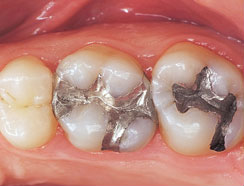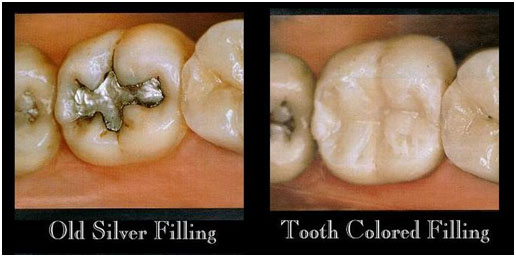
- Introduction
- Diffrent Types Of Dental Fillings
- Amalgam (Silver) Fillings
- Composite Fillings ( Tooth Colored Fillings )
- Glass Lonomer Fillings
- Amalgam v/s Composite Fillings
- Frequently Asked Questions
Introduction
A dental filling is a type of restoration used to repair tooth fractures, tooth decay or otherwise damaged surfaces of the teeth to restore anatomy, integrity, function , aesthetics and to prevent further loss of tooth structure. Dental filling materials, which include composite, porcelain and silver amalgam, glass ionomer may be used to even out tooth surfaces for better biting or chewing.
To know more about dental fillings please Click here.
Diffrent Types Of Dental Fillings
Amalgam (Silver) Fillings
Amalgam Fillings (Silver Fillings) are used for many decades for dental filling treatment. Nowadays amalgam fillings are becoming less popular because their colour don't match with teeth and do not look natural. Amalgam Fillings which are popularly known as metal fillings are made with mixture of silver and other metals like copper or zinc, grounded into powdered form. The silver powder is mixed with mercury and placed into the cavity preparation where it is shaped before hardening.
In recent years, the safety of amalgam fillings has come under scrutiny because of the mercury it contains. The absorption of elemental mercury is known to be a contributing factor to several diseases, including Alzheimer's, multiple sclerosis, dementia and arthritis. However, recent studies have proved amalgam fillings to be perfectly safe. It is true, that mercury vapor is toxic but mercury molecules in hardened amalgam are bound to the silver molecules rendering the level of toxicity harmless.
Photograph Showing Amalgam Filling
To know more about silver amalgam fillings Click here.
Composite Fillings
Composite fillings are the newest type of filling in common usage. Composite fillings are also known as white fillings. They are a porcelain/plastic hybrid that is bonded directly to the cavity preparation. Composite fillings were created as an alternative to traditional metal dental fillings. They are colored to look like natural teeth and are more aesthetically pleasing than amalgam or gold fillings. Composite fillings are also strong, durable, and make for a very natural looking smile.
A special dental material is then used to open up the pores of your tooth's dentin and roughens up the surface of the exposed enamel. This creates a stronger bond between the tooth and the filling. The bond resin is applied to stick the composite to your tooth. This material is made of the same dental resin as the composite however it is much more fluid.

Amalgam Filling Changed to Composite Filling
To know more about composite fillings Click here
Glass Lonomer Fillings
Glass ionomer fillings form a chemical link with the tooth. They may also release fluoride, which helps to prevent further tooth decay. This type of filling is fairly weak and, because of this, is usually limited to use on baby teeth and non-biting surfaces such as around the necks of the teeth. Little preparation is needed as the filling bonds directly to the tooth. Glass ionomer cement (GIC) is one of a class of materials commonly used in dentistry as filling materials and luting cements. These materials are based on the reaction of silicate glass powder and polyalkeonic acid.
As they bond chemically to dental hard tissues and release fluoride for a relatively long period modern day applications of GICs have expanded. The desirable properties of glass ionomer cements make them useful materials in the restoration of carious lesions in low-stress areas such as smooth-surface and small anterior proximal cavities in primary teeth. Results from clinical studies also support the use of conventional glass ionomer restorations in primary molars

To know more about glass ionomer fillings Click here.
Amalgam v/s Composite Fillings
Safety and Appearance: In addition to having a more pleasing and natural tooth-like appearance, composite fillings have the potential advantage of not containing mercury or other metals that may contribute to sensitivity or toxicity. Mercury toxicity from amalgam fillings is a controversial subject, though no research to date has been able to show any risks of having mercury as a component of amalgam dental fillings. However, many patients do have metal sensitivities and some have reported a metal taste after the placement of amalgam fillings.
Durability: Composite fillings previously were not as durable as amalgams. However, dental manufacturers have made great strides in improving the strength of composite resin materials, to the effect that composite fillings now have the potential to be used for all teeth, including molars. Furthermore, composite materials often require less tooth preparation and may not weaken the affected tooth as much as amalgam fillings, which often require more extensive tooth preparation. However, amalgam fillings do have a long-term track record and may last longer than composite fillings.
Tooth Shaping: Composite and amalgam fillings require preparation of the affected tooth, but less preparation is usually required for a composite filling. Typically, this means that less healthy tooth structure has to be removed when placing a composite
Technique and Time: More than amalgam fillings, the success of composite fillings depends on your dentist's technique and are technique sensitive. Composite filling restoration also requires the use of additional equipment, and the procedure itself requires up to 50% more time than the amalgam filling procedure. These factors contribute to the higher costs associated with composite fillings.
Skill: Most dentists are skilled in composite fillings, but their level of skill may vary. Selecting the appropriate dentist is an important factor in treating tooth decay or similar damage. Ask if your dentist has obtained the kind of post-graduate education that allows dentists to refine their skills in composite restorations.
If you spend some time understanding the differences between the various restorative procedures and the materials used for each, you will be better informed as to the option that works best for you. Consult with your dentist to determine the treatment time, cost, functionality and esthetic value of all available restorative treatments for decayed or damaged teeth.



"A healthy smile is a beautiful smile"
Contact us now to schedule an appointment.

